I will start my insights on three of Istanbul must-sees with a tip: spread these visits on three separate days, one for each day, and leave the rest of the time for other things: the Basilica Cistern, the Spice Bazaar or Süleymaniye Mosque.
The Blue Mosque
The Blue Mosque is the most famous mosque in Istanbul and its silhouette is almost as recognizable as that of the Tour Eiffel in Paris. It is huge: you can spend plenty of time sitting in the main courtyard, reading a book or watching the people go by. Of course before entering you have to take off your shoes and, if you are a woman, cover your head. The entrance is free of charge, but during prayer time the mosque is closed to the public.
The interior of the mosque is beyond beautiful: it is peaceful and harmonious, all covered in Iznik tiles, and on the floor there is of course a soft carpet. It was the first time that I entered a mosque, and the first time seeing a Muslim person praying. It must be awkward to be there for spiritual reasons when nearly everybody else is merely looking at the dome and taking pictures.
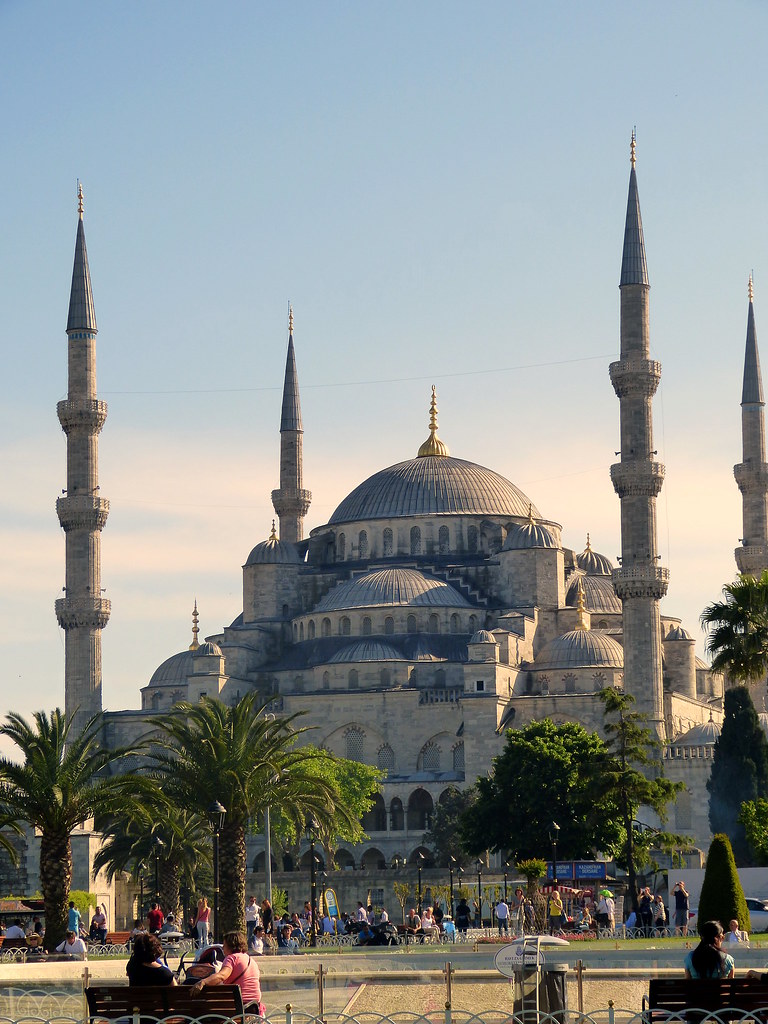 |
| The beautiful Blue Mosque, the most important mosque of Istanbul |
The interior of the mosque is beyond beautiful: it is peaceful and harmonious, all covered in Iznik tiles, and on the floor there is of course a soft carpet. It was the first time that I entered a mosque, and the first time seeing a Muslim person praying. It must be awkward to be there for spiritual reasons when nearly everybody else is merely looking at the dome and taking pictures.
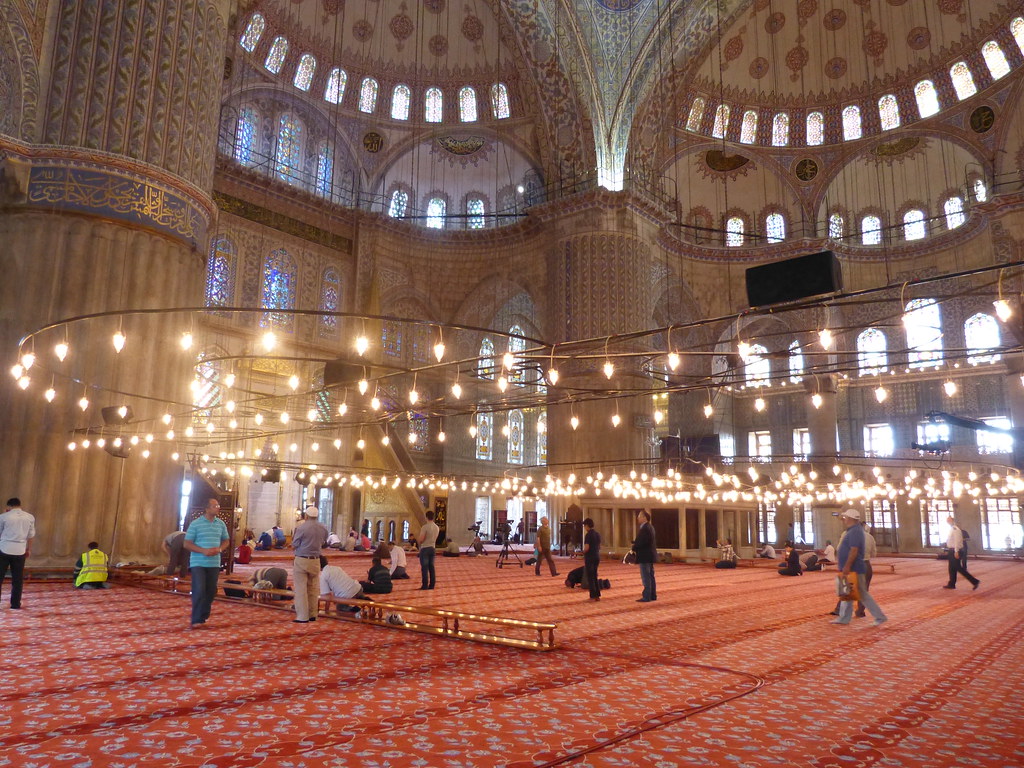 |
| Interior of the Blue Mosque |
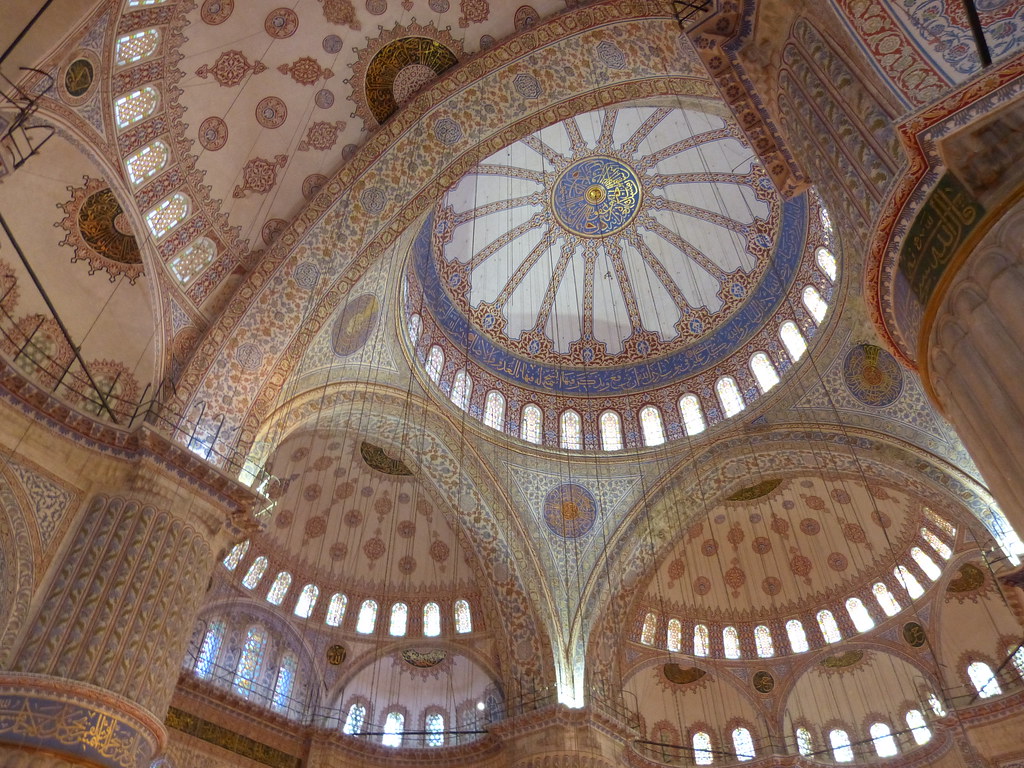 |
| The interior of the mosque |
This mosque, built at the beginning of the 17th century, has no less than 6 minarets (at the time of the construction 4 was the norm), ablution fountains, and in the past it had facilities like kitchens and a madrasah, a religious school. Even if you are not religious, this place should encourage you to reflect on the meaning and purpose of life and to contemplate what beauty is. The mihrab, a niche that indicates the direction of Mecca, is made to look like a cascade of stalactites, like many other decorations in the interior and exterior of the mosque. It was a pleasant experience to visit it, and I learned so much about Islamic architecture just from observing the details.
Topkapi Palace
Of the three major sights my favourite is probably Topkapi, the palace of the Ottoman sultans. I woke up early on my second day in Istanbul and walked to the main entrance, just a few hundred metres from my hostel. There was no queue to buy the tickets. Even though some monuments in Istanbul can have a relatively high entrance fee, they are usually worth every penny. A visit to Topkapi Palace will cost you 25TL (€9,20 or $12,60 for my American readers), plus an additional 15TL (€5,5/$7,40) for the harem. If you're stripped on cash I suggest that you visit the former only. The construction of the palace began in the 15th century, after Sultan Mehmet II had conquered what was then Costantinople.
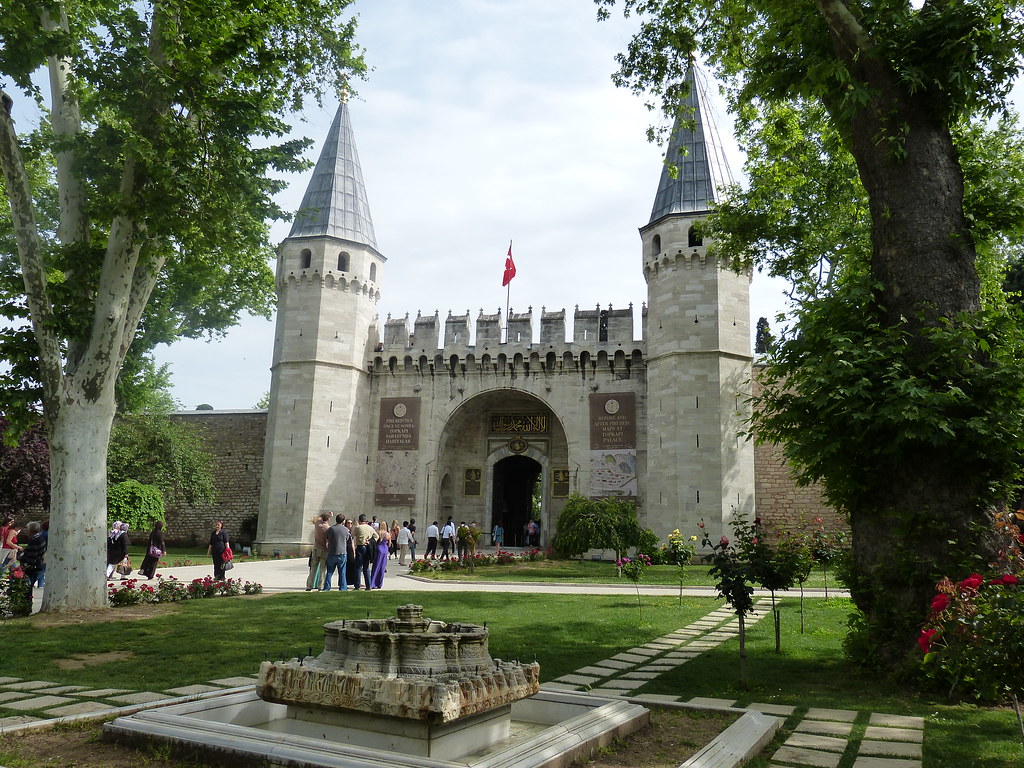 |
| Gate of Salutations, entrance to Topkapi Palace |
Topkapi Palace is a huge complex, made of four different courtyards. It took me several hours to explore it, but not for one moment I was bored, because the palace is very beautiful and I had a good guidebook explaining the functions of the different areas and a bit of history of the Ottoman Empire. Ottoman Palaces are different from what we are used to in Western Europe, as there are pavilions appearing almost randomly in an interlocked set of gates and courtyards, rather than a single block working around a garden.
The first room that you will visit is the Divan, the Council Chamber, with its beautiful golden gate. Many rooms in Topkapi have cushions or sofas placed against the walls, so you can easily imagine the members of the court - the sultan, the concubines, and the grand vizier, a sort of prime minister of the Ottoman empire - living in luxury. Incidentally, the word "divan" entered Western languages through these Middle Eastern council chambers.
The first room that you will visit is the Divan, the Council Chamber, with its beautiful golden gate. Many rooms in Topkapi have cushions or sofas placed against the walls, so you can easily imagine the members of the court - the sultan, the concubines, and the grand vizier, a sort of prime minister of the Ottoman empire - living in luxury. Incidentally, the word "divan" entered Western languages through these Middle Eastern council chambers.
The decorations and the inlay work are superb. I couldn't stop admiring the tiles, the golden rims of the buildings, and the elaborated details of every pavillion.
Sometimes the sultan eavesdropped the decisions of the imperial council through the golden gate. Imagine that!
 |
| Gate to Divan (Council Chamber) |
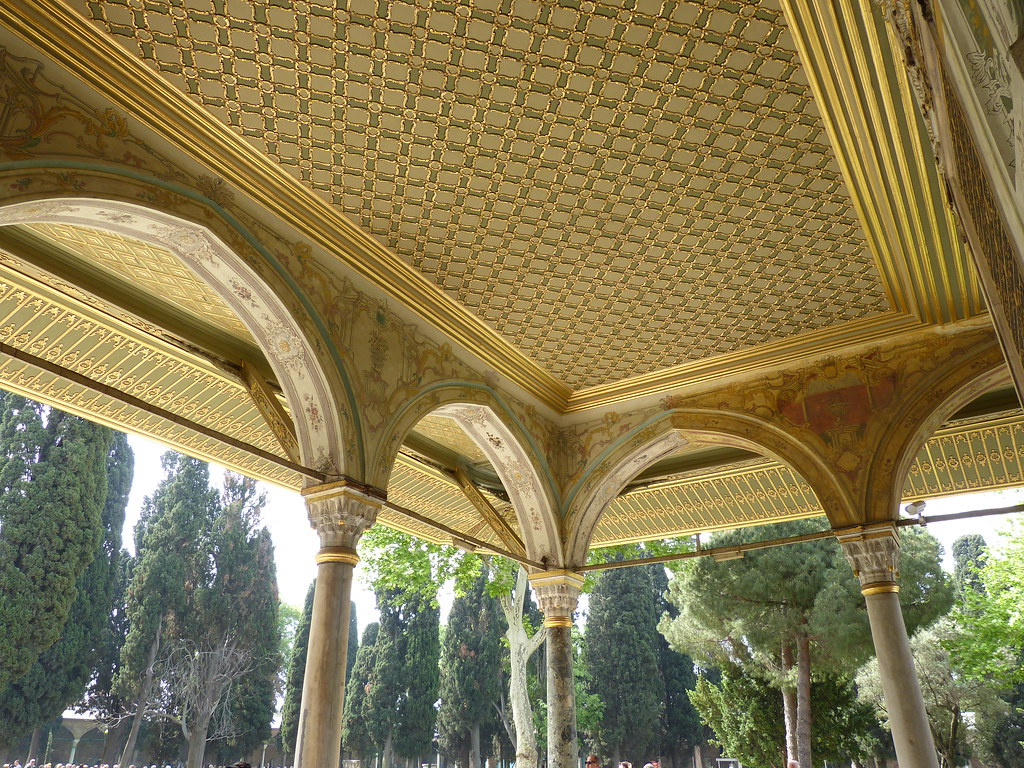 |
| The beautiful decorations of the divan |
 |
| Inside the divan |
Another beautiful and harmonious room is the Audience Hall, which is located after the Gate of Felicity.
Here the Sultan received foreign ambassadors and discussed the affairs of the state.
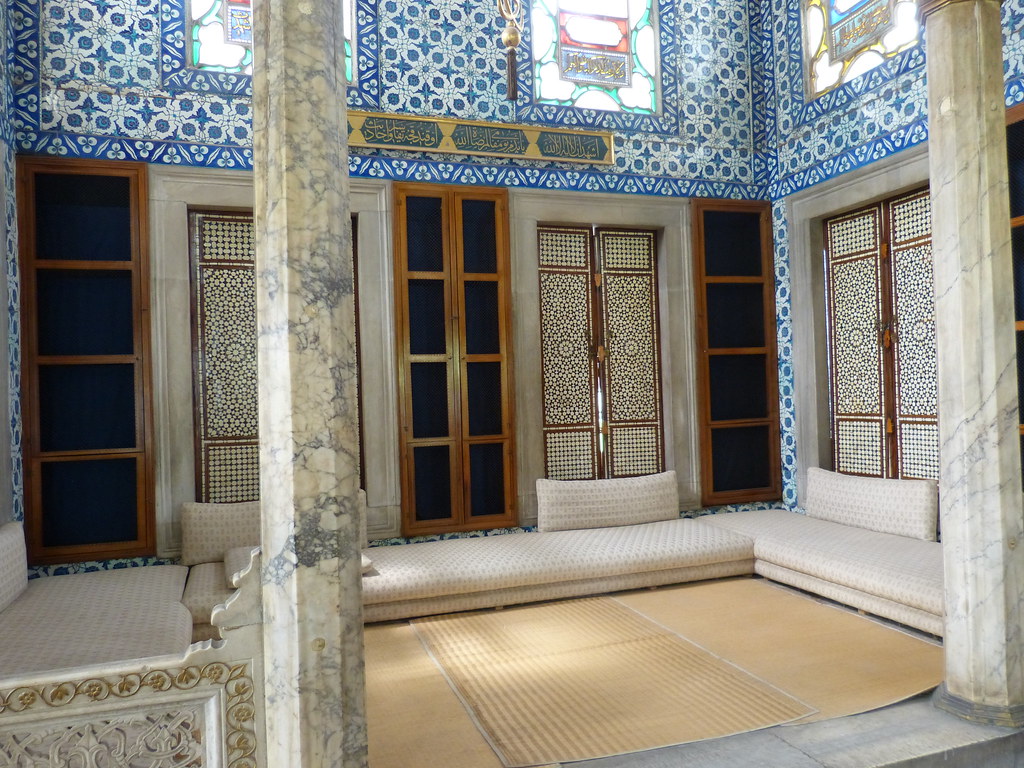 |
| Can you imagine discussing state affairs here? |
Another area I enjoyed is the pool with the jets with some beautifully-decorated buildings around it like the Baghdad Kiosk or the Revan Kiosk, both built to commemorate a victory over said cities (now in Iraq and Armenia).
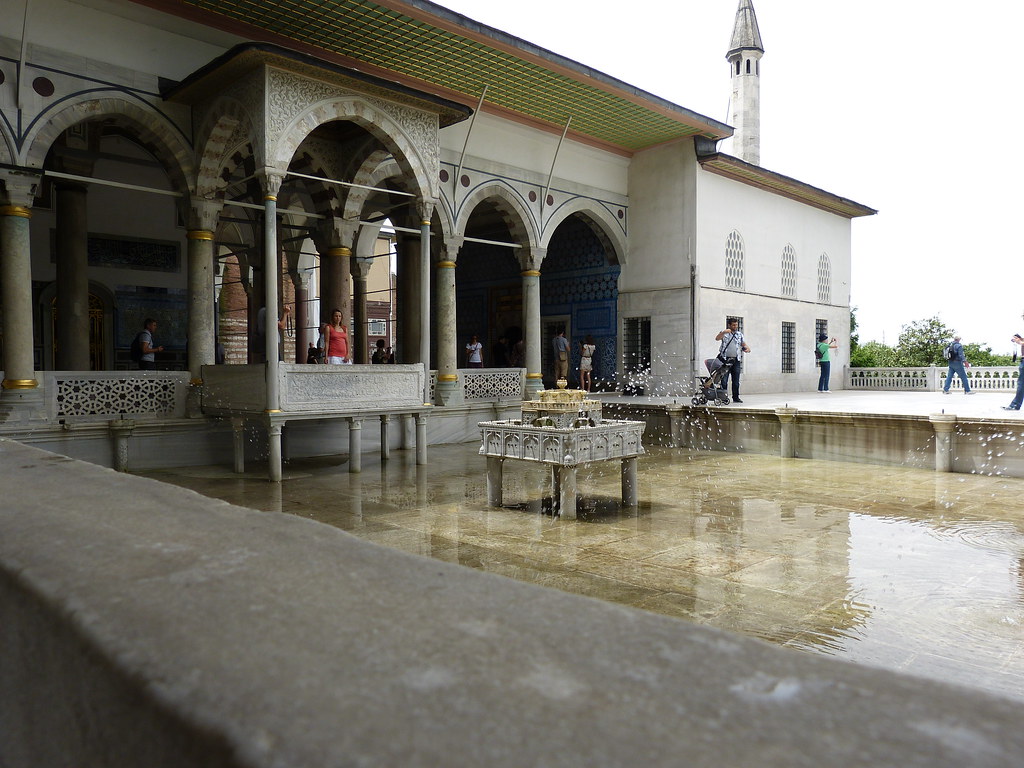 |
| Pool with jets |
 |
| One of the many pavillions |
The Treasury is the most crowded area of the palace. There are some objects of outstanding beauty here, but having to push and being pushed just to see something behind a glass case has ruined my experience of it. It seemed to me that many tour groups went very swiftly through all the other rooms just to congregate here and see things like the Emerald Dagger, or the Spoonmaker's Diamond. The latter is a giant diamond whose origins are enveloped in legend. To be honest, I appreciated the arms collection a lot more. Not many people there in contrast with the rest of the palace.
The harem is accessed from the left side of the second courtyard. I started this second visit after drinking a fresh juice sitting on the grass of one of the courtyards. The harem was not only the area of the palace where the concubines lived, but it more simply designated the private quarters, as opposed to the state rooms. It is less crowded, because some people simply skip it, miss it (it's not that well-signed) or because it's not included in all the guided private tours.
In general, the rooms of the Harem are smaller and less obviously luxurious, since they were used for private purposes only. There are however some exceptions. The sultan's privy chamber, for example, is located in this area of the palace. It includes a marble fountain where cascading water also served the purpose of making it difficult to eavesdrop the sultan's conversations.
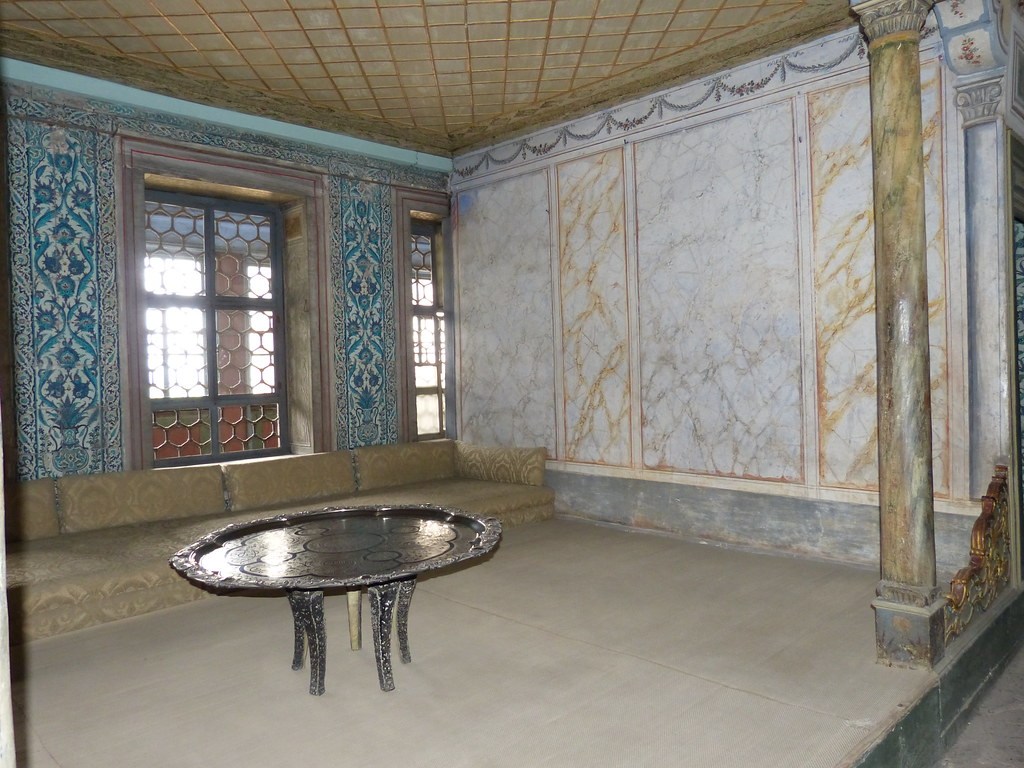 |
| Harem Interior |
In general, the rooms of the Harem are smaller and less obviously luxurious, since they were used for private purposes only. There are however some exceptions. The sultan's privy chamber, for example, is located in this area of the palace. It includes a marble fountain where cascading water also served the purpose of making it difficult to eavesdrop the sultan's conversations.
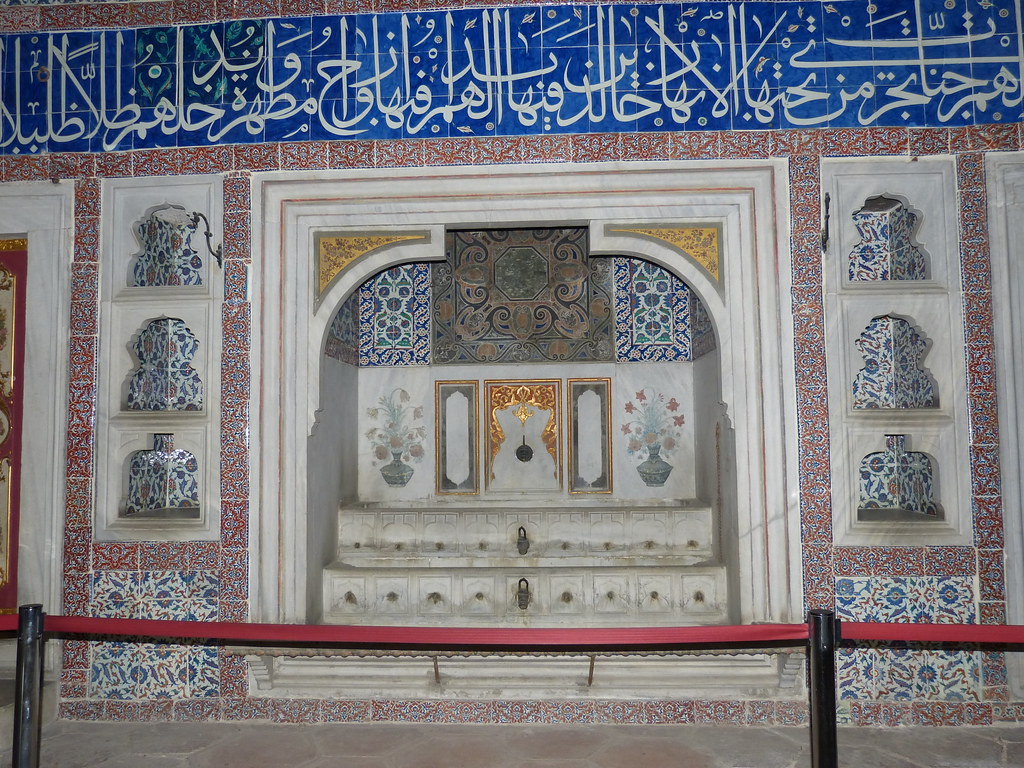 |
| The three-tiered fountain |
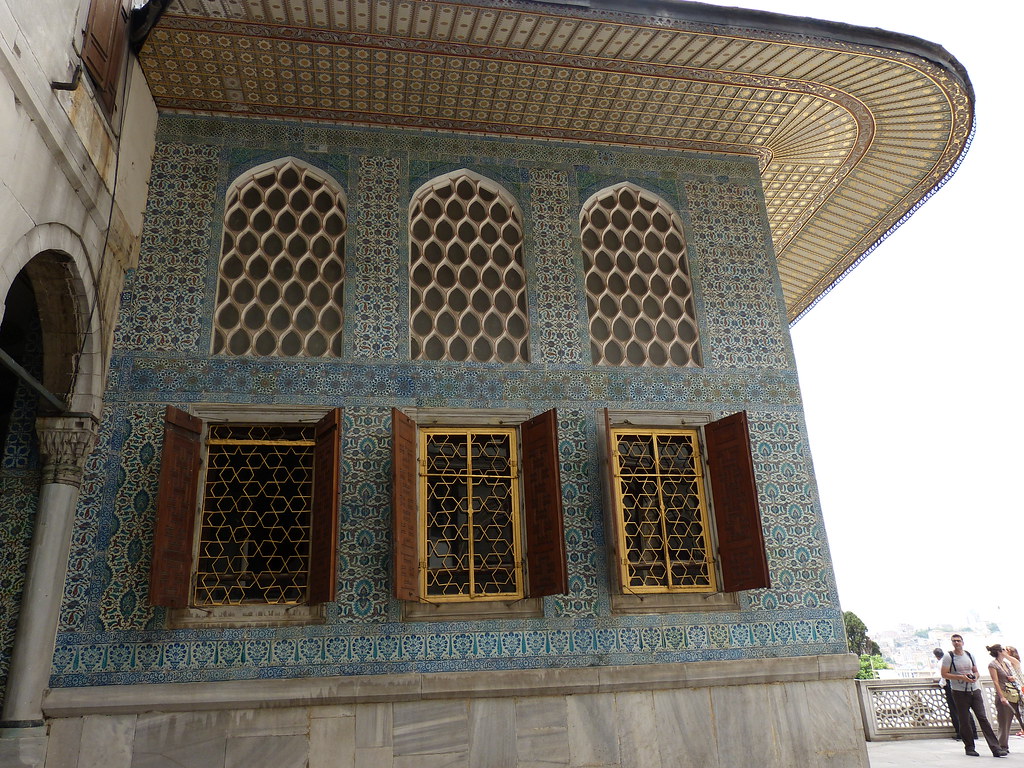 |
| I loved this building! |
Hagia Sophia
On the morning of my third day I visited Hagia Sophia. I woke up late, so when I reached it there was a long long queue. After queuing for the ticket, there is a second queue to wait for your turn to enter. The price is steep (25TL), but I think it's silly to visit Istanbul and don't enter Hagia Sophia. I suggest that you plan carefully and arrive when the ticket office opens, at 9 am.
Hagia Sophia is one of the most important religious buildings in the world. It is not a church anymore, but it's not a mosque either. First built as a church and later converted into a mosque it is now considered a museum, in order not to offend anyone. Having seen the Basilica of St. Mark in Venice several times and the Byzantine churches in Ravenna, I was used to golden mosaics. Only here everything is much bigger! If the building seen from outside is definitely nothing special, from the inside it is completely different and astonishing in size.
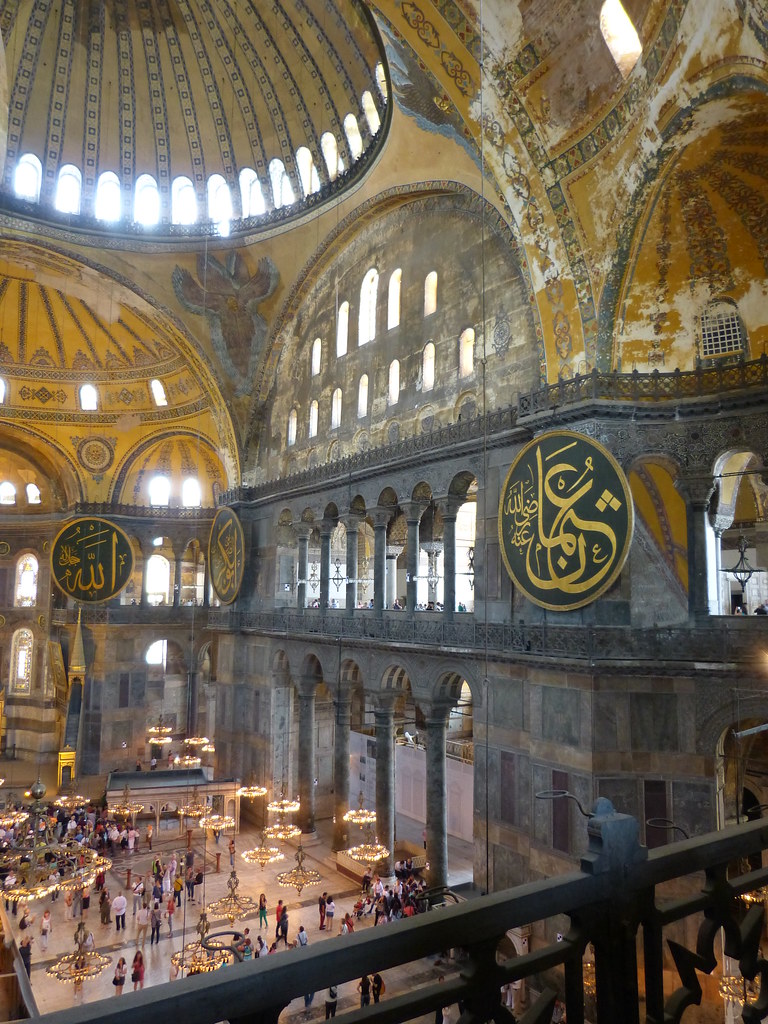 |
| Hagia Sophia from the the upper floor |
I must confess that the medallions with Arabic inscriptions clash against the otherwise Christian imagery of the mosaics. As a matter of fact, they were covered when Hagia Sophia was used as a mosque. It was Ataturk, the founder of modern Turkey, who transformed Hagia Sophia into a museum.
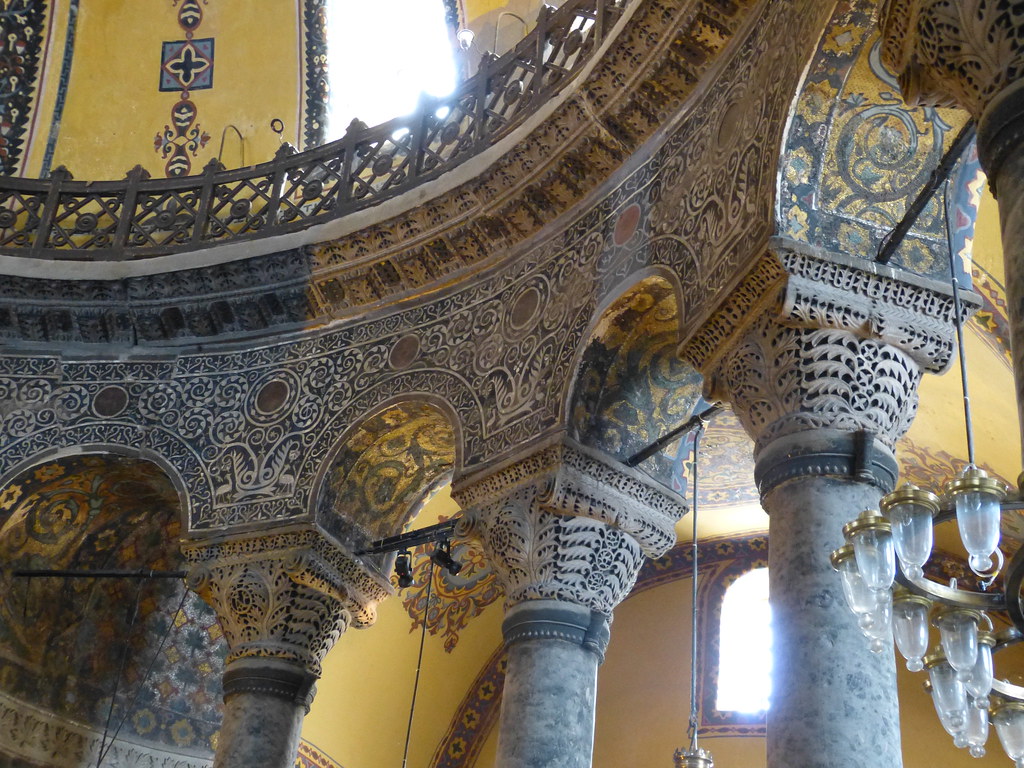 |
| Detail |
A church on this site has existed since the 4th century AD, but the current one was ordered by Byzantine emperor Justinian I in 532. In Hagia Sophia you can also find the grave of Enrico Dandolo, doge of Venice, who ransacked the city during the fourth crusade, and then stayed on with the title of Latin Patriarch of Costantinople, subservient to the Pope.
I stopped at each mosaic, trying to make out the different symbols and the iconology. I couldn't get enough of the stories they told. Empress Zoe, with her three husbands whose portraits were added and then removed from the mosaics in this church particularly fascinated me.
I stopped at each mosaic, trying to make out the different symbols and the iconology. I couldn't get enough of the stories they told. Empress Zoe, with her three husbands whose portraits were added and then removed from the mosaics in this church particularly fascinated me.
 |
| Mosaic of Jesus |
Which one was your favourite between the Blue Mosque, Hagia Sophia and Topkapi Palace?
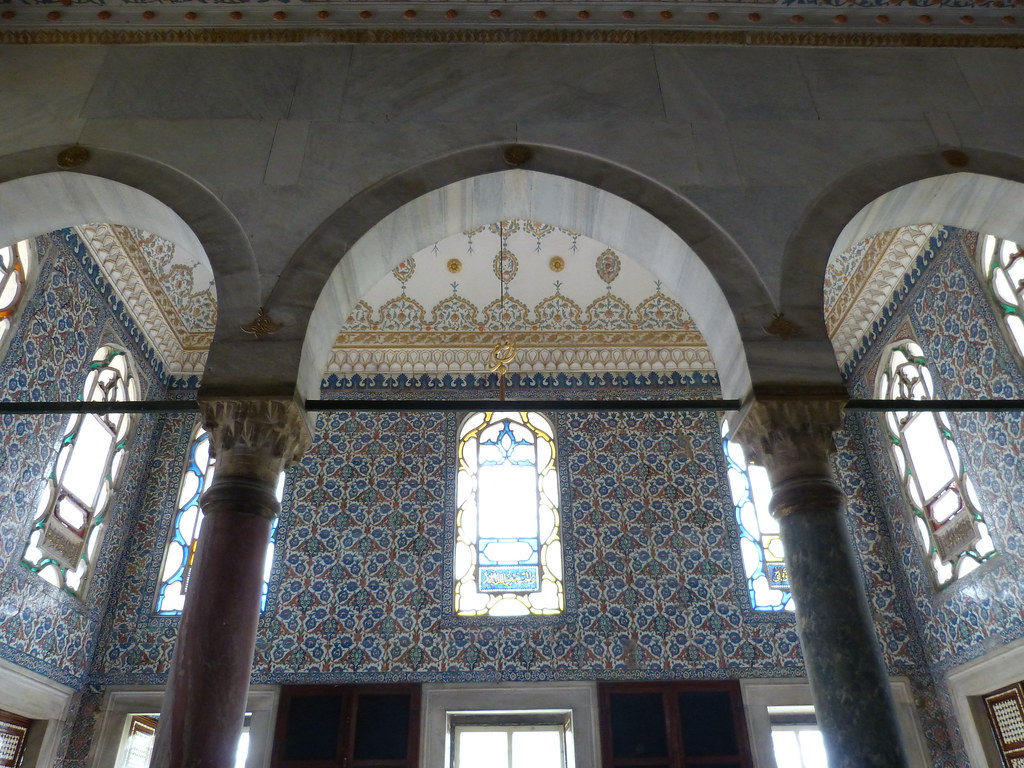
Your love for history really shines through your posts, and I really appreciate that since I also love learning all of the historical stories and tidbits behind the sites I visit. I think that we saw the Blue Mosque and Hagia Sofia on the same day and Topkapi on a separate day. All of these sites are absolutely amazing, but the Hagia Sofia absolutely took my breath away when I walked inside especially since the building is so unassuming from the outside as you mentioned. Great post!
ReplyDeleteThank you Dana, I'm glad you enjoyed my post. Hagia Sophia is certainly impressive, I think it's unique in the world.
DeleteI agree with Dana, it really does shine through which is why I love reading your posts every week! Thanks for sharing.
ReplyDeleteHappy travels :)
I can't wait to finally visit Istanbul in three weeks, but I heard the crowds are absolutely insane. Any good tips on which time of day is best for the Blue Mosque or the Hagia Sophia?
ReplyDeleteHagia Sophia is definitely better when the ticket office opens, at 9 am. The Blue Mosque is ok also in the afternoon. I was there after 5 I think and it was ok. Hopefully in early December it won't be too crowded. Have fun in charming Istanbul!
Deletenice post! this is getting me excited for istanbul, i'm going there in a few days! and good tip about the hagia sophia, i'll be sure to get there early.
ReplyDelete